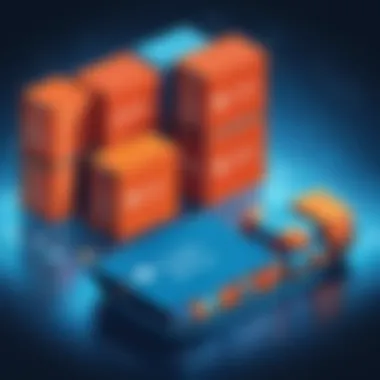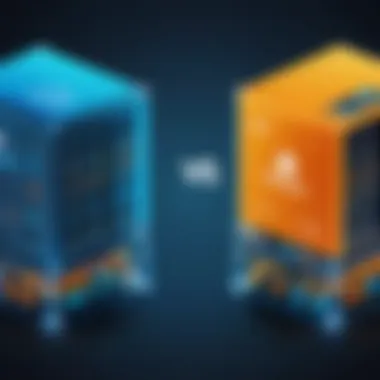Unveiling Differences and Similarities: Docker vs. Virtual Machines in Software Development


Overview of Topic
In the realm of software development and deployment, understanding the disparities and resemblances between Docker and virtual machines holds paramount importance. Docker, being a containerization platform, and virtual machines, operating with Hypervisor technology, serve as cornerstone technologies in contemporary computing.
Providing a backdrop to this comparison is essential to grasp the essence and relevance of the intricacies that lie within these intricate technologies.
Fundamentals Explained
To embark on this intellectual voyage, we must first elucidate the core tenets underpinning Docker and virtual machines. Docker operates through containerization, emphasizing portability and efficiency by encapsulating applications and their dependencies. In contrast, virtual machines simulate hardware to create isolated environments offering versatility at the cost of greater resource consumption.
Key terminologies like images, containers, VM instances, and snapshots play a pivotal role in comprehending the rudiments. Grasping these fundamental concepts will pave the way for a deeper understanding of the functionalities.
Practical Applications and Examples
Delving into real-world scenarios, Docker's agility shines through its ability to facilitate seamless application deployment and scaling. Developers can generically reduce timelines by utilizing containerization to empower Continuous Integration & Delivery practices. Conversely, virtual machines cater to scenarios where system-level isolation is imperative, as seen in scenarios requiring diverse operating systems to coexist.
Code snippets illustrating container creation in Docker and VM deployment guides showcase the practicality of these concepts. Hands-on projects implementing microservices architecture exemplify Docker's versatility, whereas virtual machines can handle legacy applications promptly.
Advanced Topics and Latest Trends
As technology evolves rapidly within the computing sphere, we encounter cutting-edge trends that shape the future of Docker and virtual machines. Innovations like Docker Swarm and Kubernetes highlight the advancement towards cluster management, emphasizing scalability and fault tolerance.
Recent advances in virtualization technology optimize resource allocation and enhance security measures within VM infrastructures. The integration of Io T and edge computing into container environments signifies a shifting paradigm towards enhanced portability and edge processing capabilities.
Tips and Resources for Further Learning
For enthusiasts eager to delve deeper into Docker and virtual machines, a plethora of educational resources awaits their indulgence.


Recommended reads like 'The Docker Book' by James Turnbull and 'Virtualization Essentials' by Matthew Portnoy offer insightful perspectives into the realm of containerization and VM technologies. Online courses from platforms such as Coursera and Udemy facilitate practical learning experiences, complementing theoretical knowledge.
In addition, tools like Docker Hub and Virtual Box provide experiential learning avenues to bolster one's proficiency in these domains.
Introduction
When delving into the comparison between Docker and virtual machines, it becomes imperative to understand the nuances that set them apart while also recognizing the similarities that bridge their functionalities in the landscape of modern software development and deployment. This article aims to dissect the core characteristics of Docker and virtual machines, offering a detailed exploration of their structures, functionalities, and use cases. By unraveling the distinct attributes of these technologies, readers will achieve a comprehensive grasp of their relevance in contemporary computing environments.
Defining Docker and Virtual Machines
In essence, Docker and virtual machines represent distinct approaches to enable the execution of applications within isolated environments. Docker, a containerization technology, operates by encapsulating applications and their dependencies into lightweight containers, facilitating efficient deployment and scalability. On the contrary, virtual machines abstract physical hardware to create virtual instances of complete operating systems, allowing for the segregation of applications and resources. While Docker focuses on containerized encapsulation, virtual machines emulate full-fledged environments, each catering to specific use cases within software development and deployment landscapes.
Significance of Understanding the Differences
Recognizing the disparities between Docker and virtual machines holds pivotal importance, particularly in optimizing resource utilization, performance efficiency, and security protocols within software infrastructures. By comprehending the distinct mechanisms of containerization and virtualization, developers and IT professionals can make informed decisions regarding the deployment of applications based on demands for scalability, speed, and isolation. Understanding these differences not only enhances operational efficiencies but also fortifies cybersecurity measures, guiding the strategic deployment of applications across diverse computing environments.
Understanding Virtualization
In the realm of software development and system management, understanding virtualization plays a pivotal role. Virtualization technologies like Docker and virtual machines enable the efficient utilization of hardware resources by creating multiple isolated environments on a single physical machine. This not only enhances scalability and flexibility but also simplifies deployment processes. Moreover, comprehending virtualization helps in optimizing resource allocation, improving performance, and maintaining system security. By delving into virtualization, individuals can grasp the intricacies of containerization and hardware virtualization, leading to more effective and seamless software deployment.
Virtual Machines: An Overview
Hardware Virtualization
Hardware virtualization involves creating virtual instances of physical hardware components, allowing multiple operating systems to run concurrently on a single machine. It enables the abstraction of physical resources like CPU, memory, and storage, ensuring efficient utilization without interference between different virtual machines. This feature is advantageous as it enhances system stability, facilitates hardware consolidation, and supports various operating systems and applications. However, hardware virtualization may introduce overhead due to emulation and can lead to performance degradation under heavy workloads, requiring careful resource management.
Virtual Hardware Components
Virtual hardware components emulate physical devices within a virtualized environment, replicating functionalities like network interfaces, storage controllers, and input devices. These components facilitate seamless communication between the virtual machine and the host system, ensuring that software running within the virtual environment can interact with the underlying hardware effectively. While virtual hardware components streamline system configuration and compatibility, improper configuration or mismatched settings can impact performance and stability, necessitating careful setup and monitoring.


Resource Allocation
Resource allocation within virtual machines is crucial for optimizing performance and ensuring equitable distribution of system resources. By defining resource limits and priorities for CPU, memory, and storage, administrators can prevent resource contention and prioritize critical workloads. Effective resource allocation enhances system stability, prevents performance bottlenecks, and allows for efficient utilization of available resources. However, improper resource allocation can lead to underutilization or resource constraints, impacting application performance and scalability, highlighting the importance of accurate resource planning and management.
Docker: A Containerization Technology
Containerization revolutionizes software development by encapsulating applications and their dependencies within lightweight containers. These containers share the host system's kernel, enabling efficient resource utilization and rapid deployment of isolated microservices. Through Docker, developers can create reproducible environments, manage dependencies effectively, and streamline the deployment process across different infrastructure environments.
Containerization vs. Virtualization
Containerization differs from virtualization by leveraging the host operating system's kernel, eliminating the need for a guest operating system for each container. This approach reduces the overhead associated with running multiple virtual machines on a single host, enhancing resource efficiency and minimizing performance degradation. While virtualization provides stronger isolation and security between instances, containerization offers greater agility, scalability, and portability, making it an optimal choice for modern microservices architectures.
Container Structure
Containers comprise application code, runtime, libraries, and dependencies bundled into a single package, ensuring seamless deployment and execution independent of the underlying infrastructure. Docker's container structure includes layers that capture changes made to the base image, facilitating rapid deployment, version control, and efficient resource utilization. This structure accelerates the development process, streamlines collaboration among team members, and simplifies continuous integration and deployment pipelines.
Docker Engine
At the core of Docker lies the Docker Engine, a lightweight and powerful container runtime that orchestrates container execution, networking, and storage management. The Docker Engine efficiently manages container lifecycle, automates container creation and deletion, and offers infrastructure-independent deployment options. By integrating with container registries and orchestration tools, the Docker Engine simplifies the deployment of complex applications, optimizes resource allocation, and enhances scalability and fault-tolerance in distributed systems.
Differences Between Docker and Virtual Machines
When comparing Docker and Virtual Machines, it is crucial to highlight the key disparities between these technologies. Understanding the differences is vital in the software development landscape as it can significantly impact deployment strategies and resource utilization. Firstly, let's delve into their contrasting approaches to resource efficiency and overhead. Virtual Machines operate on hypervisors that emulate full hardware, leading to higher resource consumption and overhead compared to Docker containers. While VMs offer complete isolation, this comes at the cost of increased resource utilization, making them less efficient in terms of resource allocation. On the other hand, Docker containers share the host system's kernel, resulting in lower resource overhead and more efficient resource utilization. This difference is pivotal for organizations aiming to optimize their infrastructure's efficiency and cost-effectiveness.
Moving on to the aspect of speed and performance, another key disparity between Docker containers and Virtual Machines comes to light. Due to the lightweight nature of Docker containers and their direct interaction with the host system's kernel, they exhibit faster startup times and enhanced performance compared to traditional Virtual Machines. This speed advantage makes Docker containers ideal for applications requiring rapid scaling and deployment, offering a significant edge in dynamic computing environments.
Lastly, the debate on isolation and security between Docker and Virtual Machines is noteworthy. Virtual Machines provide strong isolation due to their independent kernels and emulated hardware, offering a high level of security. However, this robust isolation can sometimes hinder communication and collaboration between applications running on different VMs. In contrast, Docker containers share the host OS kernel, which can lead to potential security vulnerabilities if not properly configured. While containers offer lightweight isolation compared to VMs, they provide a more agile environment for deploying microservices and containerized applications. Understanding these nuances is essential for decision-makers when selecting the appropriate technology based on their security and isolation requirements.
Similarities Between Docker and Virtual Machines


When discussing the similarities between Docker and virtual machines, it is essential to recognize the pivotal role this topic plays in comprehending modern software development and deployment practices. By examining the commonalities shared by Docker and virtual machines, individuals can grasp the fundamental principles of containerization and virtualization technologies. Understanding these similarities provides a solid foundation for making informed decisions regarding the appropriate technology to utilize in diverse computing scenarios.
Operating System Independence
Operating system independence stands out as a crucial similarity between Docker containers and virtual machines. Both Docker and virtual machines offer the advantage of encapsulating applications along with their dependencies, thereby ensuring the portability of software across various operating systems. This capability simplifies the deployment process, as developers can create applications without being restricted by the underlying operating system. The independence from specific operating systems enhances flexibility and mitigates compatibility issues, making it easier to deploy software in heterogeneous computing environments.
Ease of Deployment
Regarding ease of deployment, Docker and virtual machines exhibit similarities in streamlining the process of releasing and managing software applications. Docker's containerization approach enables developers to package an application and its dependencies into a single container, facilitating consistent deployment across different environments. Similarly, virtual machines provide a self-contained environment where applications can run independently of the host system, simplifying the deployment process. The ease of deployment offered by both Docker and virtual machines accelerates software delivery and empowers organizations to adapt quickly to changing business requirements.
Scalability and Flexibility
Scalability and flexibility represent another area of convergence between Docker and virtual machines. Both technologies offer solutions for scaling applications horizontally by replicating instances to accommodate increased workloads. Docker's lightweight containers and virtual machines' ability to allocate resources dynamically enable efficient scaling of applications based on demand. Moreover, the flexibility provided by Docker and virtual machines allows organizations to adapt their infrastructure to varying requirements, optimizing resource utilization and enhancing performance. By embracing the scalability and flexibility features of Docker and virtual machines, businesses can design robust and responsive systems that meet evolving operational needs with agility.
Use Cases and Applications
In the landscape of software development, the crucial aspect of 'Use Cases and Applications' plays a pivotal role in determining the optimal choice between Docker and virtual machines. Understanding the specific scenarios where Docker excels and where virtual machines prove to be more beneficial is instrumental for streamlining development and deployment processes. By examining real-world applications and scenarios, developers can leverage the strengths of each technology to enhance efficiency and productivity. The careful consideration of 'Use Cases and Applications' ensures tailored solutions that align with project requirements, resource constraints, and scalability needs. Therefore, delving into this domain equips professionals with the strategic insights required to navigate the complexities of modern software deployment.
When to Use Docker
When contemplating the utilization of Docker, several factors come into play. Docker presents itself as an optimal choice in scenarios where lightweight and fast containerization is essential. By encapsulating applications within containers, Docker streamlines deployment processes and facilitates seamless integration across different environments. Additionally, Docker shines in microservices architectures, where scalability and flexibility are paramount. Leveraging Docker in development environments enables efficient collaboration, version control, and experimentation without the overhead associated with traditional virtual machines. Moreover, Docker proves advantageous in scenarios where a high level of portability is required, allowing applications to run consistently on various platforms. Ultimately, opting for Docker is ideal when agility, resource efficiency, and ease of management are key priorities in the software development lifecycle.
When to Use Virtual Machines
Virtual machines offer unique benefits that make them the preferred choice in certain use cases. When dealing with legacy applications or operating systems that demand full isolation, virtual machines provide an isolated environment with dedicated resources. In production environments requiring robust security measures and strict compliance standards, virtual machines offer a higher level of isolation compared to containers. Moreover, virtual machines excel in scenarios where varying operating systems need to coexist on the same physical machine, enabling efficient resource utilization and management. In demanding workloads that necessitate substantial computational resources, virtual machines ensure consistent performance by allocating dedicated hardware resources. Therefore, selecting virtual machines is advisable when stringent security requirements, legacy system compatibility, and resource-intensive workloads are paramount considerations in software deployment.
Conclusion
Evaluating the Ideal Choice
When considering the ideal solution between Docker and virtual machines, various factors come into play. It is essential to weigh aspects such as resource allocation, performance, scalability, security, and ease of deployment. Docker's containerization technology offers lightweight and flexible deployment options, making it ideal for applications that demand rapid scalability and efficient resource management. On the other hand, virtual machines provide a higher level of isolation and security, suitable for applications requiring strict separation from the host system. By evaluating the unique strengths and weaknesses of Docker and virtual machines against project requirements, users can determine the optimal choice that maximizes efficiency and meets their desired outcomes.
Future Trends in Containerization and Virtualization
As technology continues to evolve at a rapid pace, the landscape of containerization and virtualization is poised for further advancements. Future trends in these domains suggest a progression towards enhanced integration, automation, and orchestration capabilities. Container orchestration tools like Kubernetes are gaining prominence for managing complex containerized environments, driving the shift towards more dynamic and scalable infrastructures. Additionally, innovations in virtual machine technologies aim to optimize performance and resource utilization, paving the way for more efficient and cost-effective solutions. By staying abreast of emerging trends in containerization and virtualization, developers and IT professionals can leverage these innovations to streamline their processes and stay ahead in the ever-evolving realm of technology.







